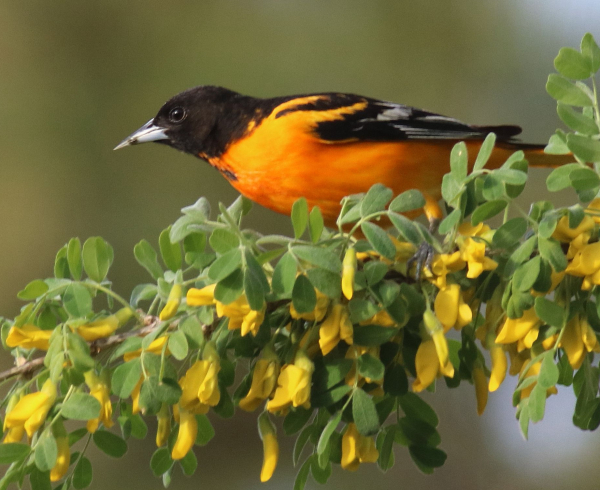
Orioles and hummingbirds feed on flower nectar and insects, and can be attracted to your feeding station by offering sugar-water for hummingbirds and oranges and jelly for orioles (Baltimore Oriole photo by Paul Konrad).

The Duncraft Oriole Delight Feeder provides comfortable feeding ports for cut oranges and grape jelly – the orange feeder catches the eye of orioles from a distance.

The new Perky-Pet Maple Top-Fill Glass Hummingbird Feeder provides a unique addition to any feeding station.
|
After a winter of following a pretty static regimen of filling feeders – mostly seed and suet feeders north of the Sunbelt – the new spring reminds us to stay versatile as the birds that visit your yard begin to change with some species leaving for more northern climes, and others arriving from the south. This early changing of the guard is just the beginning of what will be a growing need to change of elements at your feeding station. Soon, orioles and hummingbirds will begin arriving, along with grosbeaks and other songbirds – it’s time to prepare for these exciting species and others.
Neotropical migrants like hummingbirds and orioles may not arrive in your neighborhood for a few more weeks, but just in case, it’s time to take a look at your feeders, clean them if necessary; check to see if you have plenty of sugar or nectar syrup; stock up on grape jelly, and put oranges back on your shopping list. Hummingbirds and orioles appreciate sugar-water nectar, which many people prefer to mix themselves, using the traditional one cup of sugar to four cups water. Some birders buy a prepared sugar-based syrup that they mix with water in similar fashion. Many birders provide two different nectar feeders – one for hummingbirds and one for orioles, and this is a good plan so there is less competition at the feeders, plus the oriole feeders provide more substantial perches than hummingbird feeders.
Actually, though, orioles haven’t shown much interest in our nectar feeders. Therefore, we emphasize providing sliced orange halves and, most important, grape jelly at our feeding station. You can simply place the orange halves and a small bowl of grape jelly on a platform feeder, but with so many attractive hanging oriole feeders on the market, consider buying a specially designed and orange-colored oriole feeder.
Orange Halves & Jelly – While orioles are attracted to the color orange, similar to the preference for red by hummingbirds, we’ve found that while orioles tend to feed on oranges the first few days after arriving in May, they tend to lose interest in the oranges and feed almost exclusively on grape jelly. In fact, we had very little luck attracting orioles the first couple years when we offered orange halves exclusively; orioles showed little interest and didn’t stay in the area. But as soon as we offered grape jelly, everything changed. Suddenly a dozen orioles were vying for the jelly, and pairs of Baltimore and Orchard Orioles remained in the yard, nested, and brought their fledglings to the oriole feeder. Now, orioles are our favorite summer feeder visitors. What a dramatic change grape jelly made!
Exterior Design – Take some time to take a look at the variety of oriole and hummingbird feeders offered by the primary bird feeding companies at the Wild Birds Unlimited, Duncraft, and Perky Pet websites. Realistically, your choice of a hummingbird feeder and oriole feeder can make a big visual difference to your feeding station, so you should really consider your next feeder addition as a form of exterior design – and there are plenty of exciting options to consider.
Reorganizing? – Actually, while considering the overall look of your feeding station, it’s a good time to rethink, improve, or reorganize your feeding station setup. Organizing or reorganizing may even be in order, and that may best be addressed simply by using a central feeding station pole and hanger system. To begin with, check out the Advanced Pole System, which may provide all you need with lots of options for just the right number of hangers, plus squirrel and raccoon baffles and more at Wild Birds Unlimited at https://www.wbu.com/products/advanced-pole-system/
Solving Spring Problems – Nectar feeders utilize sugar, which often attracts ants and bees in addition to birds. So while you’re checking out the new line of feeders, you may want to add an Ant Moat to your order. Some nectar feeders have built-in ant moats, and some have built-in Bee Guards, which can solve ant, bee, or wasp problems.
Soon, regular suet should be replaced with “Summer Suet,” or “No-Melt Suet,” which holds up better during the warmer summer months. If squirrels become a problem, it’s a great plan to switch to “Hot Pepper Suet,” which is a no-melt type of suet that repels squirrels and other mammals, but birds seem immune to its “hot” taste and feed normally on this suet mix.
Sometimes, a transient flock of starlings, grackles, or blackbirds may overpower your suet feeder for a period, which may require you to simply remove the feeder until the flock passes out of your neighborhood. We have found that other suet-feeding birds like woodpeckers and nuthatches will opt for gleaning seeds from a hopper feeder – the larger “black” birds can’t easily perch at many hopper feeders. Then, after the problem birds move on, return the suet feeder to your feeding station mix, hopefully without further interruptions.
Overall, just like preparing your nest boxes for cavity nesting birds, be sure to plan for the arrival of neotropic migrants including orioles, hummingbirds, and more. And next week we’ll take a good look at bird bath and water feature options for resident birds and neotropical migrants. It’s all part of the excitement of what we like to think of as ever-improving our feeding station and property to attract our preferred birds – for our benefit, and theirs.